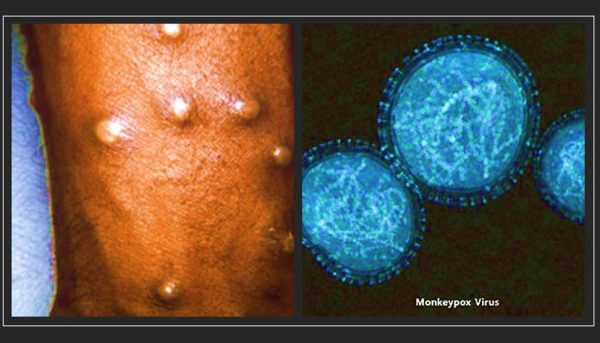
Monkeypox Outbreak – Symptoms And Treatment
Monkeypox an extremely rare disease is spreading around the world. So far more than 250 cases are reported from 16 different countries. The diseases spreads with close and prolonged contact with an infected person.
According to Rosamund Lewis, Head of the Smallpox secretariat of WHO emergencies Program, ‘the countries that are reporting the monkeypox now are those countries that do not normally have monkeypox outbreaks’. The emerging disease Monkeypox is endemic to tropical rainforests in west and Central Africa, but now it is increasingly seen spreading in urban areas too as per WHO. Monkeypox is endemic to Benin, Cameroon, the Central African Republic, Congo (both Democratic and Republic), Gabon, Ghana (in animals only) Ivory Coast, Liberia, Nigeria, Sierra Leone and South Sudan.
This year the first case of monkeypox in US reported in Massachusetts when a patient hospitalized with symptoms. According to CDC, in 2021 two passengers traveling from Nigeria to US were diagnosed with monkeypox. In UK monkeypox was reported in people who did not travel or did not had contact with those who had monkeypox. Since May 13th of this year cases of monkeypox have been reported to WHO from its 12 member states are not endemic to monkeypox virus.
Cases of monkeypox in non endemic countries reported to WHO between 13th to 21st May are:
Australia, Belgium, Canada, France, Germany, Italy, Netherlands, Portugal, Spain, Sweden, UK and USA.
Reported cases so far have not established travel links to an endemic area where the monkeypox originated. Cases have mainly been identified (but not exclusively) amongst men who have sex with men (MSM) seeking care in primary care and sexual health clinics. PCR test have identified samples as being infected with West African Clade.
Epidemiology of Monkeypox: It is a virus or viral zoonosis ( virus transmitted to humans by animals) with symptoms similar to smallpox. However it is less severe. Virus belongs to Orthopoxvirus genus of the Poxviridae family. The name monkeypox originates from the initial discovery of the virus in monkeys in Danish Laboratory in 1958. It was first identified in a child in Democratic Republic of the Congo in 1970.
Transmission: Monkeypox virus is transmitted from one person to another by close contact with lesions, body fluids, respiratory droplets and materials that are contaminated by infectious person. Incubation period is +6 to 13 days and range from 5 to 21 days (WHO).
People who have compromised immune system or those individuals who have suppressed immune systems are susceptible to the virus. This include children, pregnant women, cancer and patients with other serious conditions.
Between West African clade and Congo Basin clade – West African clade appears to cause less severe disease. Fatality rate in case of West African clade is reported so far is, 3.6% vs. 10.6% in Congo Basin clade.
Symptoms:
- Headache
- Acute onset of fever (above 38.6C)
- Swollen lymph nodes
- Myalgia or body aches
- Back pain
- Asthenia
- And acute rash: Rashes are hard to miss, it starts as macules which are flat lesions. Later it forms a firm nodule which becomes a blister and pustule that contains pus and it scabs over.
People may be contagious at the early signs of fever and stay infectious through the rash until the skin scabs and heals over (ucdavis.edu)
There is a misconception that monkeypox is related to Covid-19. No, monkeypox is not related to Covid-19 and it is related to smallpox.
Treatments:
According to WHO, Vaccines used during the smallpox eradication programme also provided protection against monkeypox. Newer vaccines have been developed of which one has been approved for prevention of monkeypox.
Smallpox vaccine has some cross protection against monkeypox. If the vaccine is given within four days of exposure it protects the person about 85% of the time. Vaccine is effective and makes the disease less severe. Other treatments include, antivirals and immunoglobulins that helps to treat the symptoms.
If you think you are exposed to monkeypox contact your health care provider.
Note from World Health Organization about Monkeypox:
Prevention – Someone who has direct contact with an infected person, including sexual contact can get monkeypox. Steps for self-protection include avoiding skin to skin or face to face contact with anyone who has symptoms, practicing safer sex, keeping hands clean with water and soap or alcohol-based hand rub, and maintaining respiratory etiquette.
Detection and care – If people develop a rash, accompanied by fever or a feeling of discomfort or illness, they should contact their health care provider and get tested for monkeypox. If someone is suspected or confirmed as having monkeypox, they should isolate until the scabs have fallen off and abstain from sex, including oral sex. During this period, patients can get supportive treatment to ease monkeypox symptoms. Anyone caring for a person sick with monkeypox should use appropriate personal protective measures, including wearing a mask, and cleaning objects, & surfaces that have been touched.
Reporting – Any rash-like illness during travel or upon return should be immediately reported to a health professional, including information about all recent travel, sexual history and smallpox immunization history. Residents and travellers to monkeypox-endemic countries should avoid contact with sick mammals such as rodents, marsupials, non-human primates (dead or alive) that could harbour monkeypox virus and should refrain from eating or handling wild game (bush meat).
Image credit: https://health.ucdavis.edu/
References:
https://www.who.int/emergencies/disease-outbreak-news/item/2022-DON385
Author: Sumana Rao | Posted on: July 26, 2022
« How to starve and kill prostate cancer cells? August is National Immunization Awareness Month »






















Write a comment